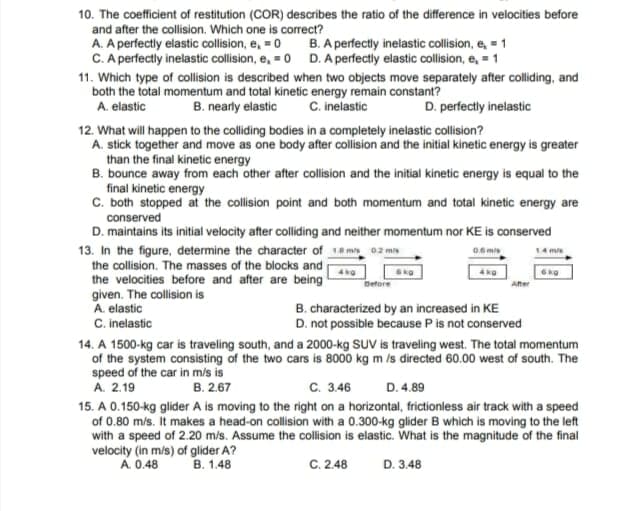10. The coefficient of restitution (COR) describes the ratio of the difference in velocities before and after the collision. Which one is correct? A. A perfectly elastic collision, e, =0 C.A perfectly inelastic collision, e, = 0 D. A perfectly elastic collision, e, = 1 B. A perfectly inelastic collision, e, 1
10. The coefficient of restitution (COR) describes the ratio of the difference in velocities before and after the collision. Which one is correct? A. A perfectly elastic collision, e, =0 C.A perfectly inelastic collision, e, = 0 D. A perfectly elastic collision, e, = 1 B. A perfectly inelastic collision, e, 1
Physics for Scientists and Engineers, Technology Update (No access codes included)
9th Edition
ISBN:9781305116399
Author:Raymond A. Serway, John W. Jewett
Publisher:Raymond A. Serway, John W. Jewett
Chapter9: Linear Momentum And Collisions
Section: Chapter Questions
Problem 9.18OQ: A head-on, elastic collision occurs between two billiard balls of equal mass. If a red ball is...
Related questions
Question

Transcribed Image Text:10. The coefficient of restitution (COR) describes the ratio of the difference in velocities before
and after the collision. Which one is correct?
A. A perfectly elastic collision, e, = 0 B. A perfectly inelastic collision, e, = 1
C. A perfectly inelastic collision, e, = 0 D. A perfectly elastic collision, e, = 1
11. Which type of collision is described when two objects move separately after colliding, and
both the total momentum and total kinetic energy remain constant?
B. nearly elastic
C. inelastic
D. perfectly inelastic
A. elastic
12. What will happen to the colliding bodies in a completely inelastic collision?
A. stick together and move as one body after collision and the initial kinetic energy is greater
than the final kinetic energy
B. bounce away from each other after collision and the initial kinetic energy is equal to the
final kinetic energy
C. both stopped at the collision point and both momentum and total kinetic energy are
conserved
D. maintains its initial velocity after colliding and neither momentum nor KE is conserved
13. In the figure, determine the character of 1a m 02 mon
the collision. The masses of the blocks and
the velocities before and after are being
given. The collision is
A. elastic
C. inelastic
06 mis
14 mis
Defore
Ater
B. characterized by an increased in KE
D. not possible because P is not conserved
14. A 1500-kg car is traveling south, and a 2000-kg SUV is traveling west. The total momentum
of the system consisting of the two cars is 8000 kg m /s directed 60.00 west of south. The
speed of the car in m/s is
A. 2.19
B. 2.67
с. 346
D. 4.89
15. A 0.150-kg glider A is moving to the right on a horizontal, frictionless air track with a speed
of 0.80 mís. It makes a head-on collision with a 0.300-kg glider B which is moving to the left
with a speed of 2.20 m/s. Assume the collision is elastic. What is the magnitude of the final
velocity (in m/s) of glider A?
A. 0.48
В. 1.48
C. 2.48
D. 3.48
Expert Solution
This question has been solved!
Explore an expertly crafted, step-by-step solution for a thorough understanding of key concepts.
This is a popular solution!
Trending now
This is a popular solution!
Step by step
Solved in 2 steps

Knowledge Booster
Learn more about
Need a deep-dive on the concept behind this application? Look no further. Learn more about this topic, physics and related others by exploring similar questions and additional content below.Recommended textbooks for you

Physics for Scientists and Engineers, Technology …
Physics
ISBN:
9781305116399
Author:
Raymond A. Serway, John W. Jewett
Publisher:
Cengage Learning

College Physics
Physics
ISBN:
9781285737027
Author:
Raymond A. Serway, Chris Vuille
Publisher:
Cengage Learning

College Physics
Physics
ISBN:
9781305952300
Author:
Raymond A. Serway, Chris Vuille
Publisher:
Cengage Learning

Physics for Scientists and Engineers, Technology …
Physics
ISBN:
9781305116399
Author:
Raymond A. Serway, John W. Jewett
Publisher:
Cengage Learning

College Physics
Physics
ISBN:
9781285737027
Author:
Raymond A. Serway, Chris Vuille
Publisher:
Cengage Learning

College Physics
Physics
ISBN:
9781305952300
Author:
Raymond A. Serway, Chris Vuille
Publisher:
Cengage Learning

Physics for Scientists and Engineers with Modern …
Physics
ISBN:
9781337553292
Author:
Raymond A. Serway, John W. Jewett
Publisher:
Cengage Learning

Physics for Scientists and Engineers
Physics
ISBN:
9781337553278
Author:
Raymond A. Serway, John W. Jewett
Publisher:
Cengage Learning

Principles of Physics: A Calculus-Based Text
Physics
ISBN:
9781133104261
Author:
Raymond A. Serway, John W. Jewett
Publisher:
Cengage Learning